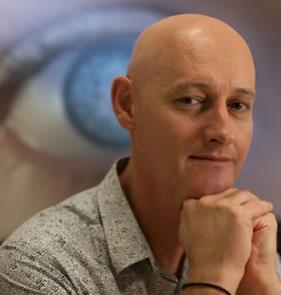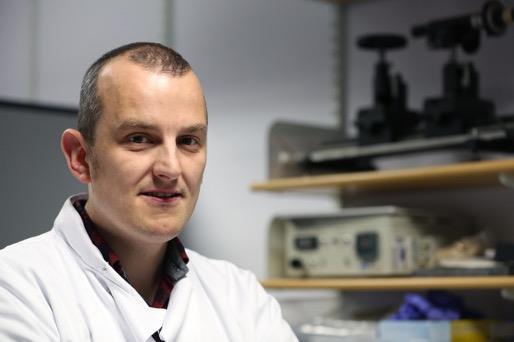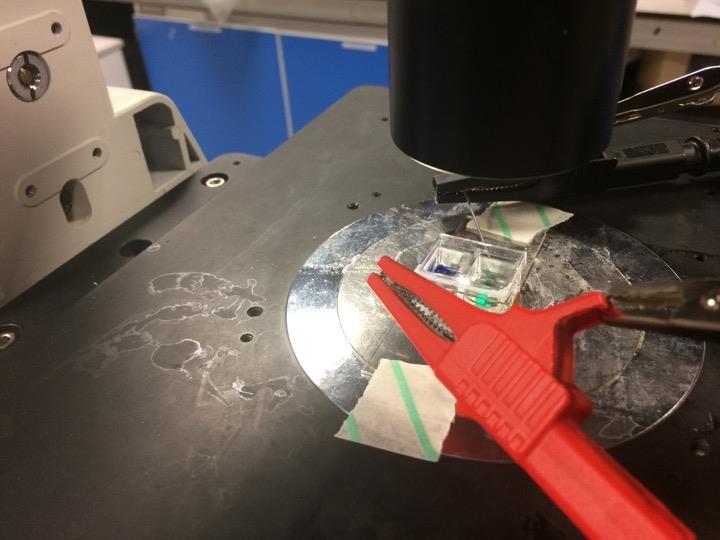“Cochlear implants currently have 22 channels of stimulation – a limitation caused by the fact they are made from metals,” Dr Green said. “Metal conducts electricity using electrons, while the body uses ions. The material we’re using can conduct electricity using both.
“Metal limits size,” she continued. “You can’t make the device smaller without compromising safety and you can’t push more current through the metal as it could cause unwanted chemical reactions, such as changing the pH in the tissue.”
The polymeric material allows current to be pushed into the body at a ‘faster rate, more efficiently and at a lower voltage’, lowering the risk of electrical changes or degradation significantly.
“This provides better perception of sound for a cochlear implant patient, or allows someone with a bionic eye to see not just with 40 or 60 points of light – which is the current limitation of metal electrodes – but with hundreds and thousands of points of light.”

Dr Green’s other challenge was to develop a polymer which could be accepted by the body. This involved modifying the properties of conductive polymers to create a soft interface that interacts more readily and reduces the foreign body response. According to Dr Green, this has been accomplished by hybridising a conductive polymer with hydrogels and elastomers.
The bionic eye developed by Dr Green comprises a camera, fitted to sunglasses, connected to a processor that converts the analogue signal into a digital format that is then delivered into the body. The electronic package sits behind the ear under the skin. An electrode lead is inserted into the eyeball, where it can stimulate cells to create a perception of vision. A chip interprets the information received.
| "Metal limits size; you can't make the device smaller without compromising safety." Dr Rylie Green |
The implants are powered via inductive coils; one remains outside the body, with a matching coil inside. When clipped together magnetically, it can be used for data transmission.
“A wireless inductive link powers the implant, sends processed information to it and gets reverse telemetry data on how the device is working inside the body,” Professor Nigel Lovell of the University of New South Wales, explained. Prof Lovell, who has been leading an R&D programme to develop a retinal neuroprosthesis and collaborates with Dr Green, continued: “The chip encodes image information from the camera into electrical pulses. The brighter the image spot, the larger the amplitude of the electric pulses. There are 99 electrodes in our array; more electrodes means better visual acuity.”

Dr Green’s polymeric material will coat the electrodes to make them work more effectively and, potentially, enable devices with more electrodes, something which is not possible with metal electrodes.
“The electronics package (where data transmission and signal generation occurs) is implanted at a distance from the sensory organ (eye or ear), but the interfacing electrode array must be implanted in contact with the cells that require activation and connected to the electronics package via a cable or tracks.” Dr Green said.
| "There are 99 electrodes in our array; more electrodes means better visual acuity." Professor Nigel Lovell |
“The more tracks and channels, the better the patient experience. Once you reach the tissue, you need to be able to stimulate and separate those channels.”
According to Dr Green, making sure that polymer-based tracks can carry electricity across these lengths is a challenge, hence the development of new polymer chemistries and fabrication techniques.
“Hydrogels are best for interacting with tissue when looking to stimulate them, but the elastomers are needed to create long tracks. The biggest challenge is creating a continuous electrical path that doesn’t break with movement. We’ve achieved that, but need to make it commercially competitive.”
Bioelectronics appears to have a role to play in future medicine and, while Dr Green is working on improved audio and visual perception for diseased cells, Dr Rawson is looking to use bioelectronics to communicate with cells wirelessly.
Instead of implanting an electronic device near the nerve tissue and applying a current to modulate cell proteins and stimulate communication, Dr Rawson has other plans.
“By inputting electric fields, we plan on modulating electron transfer, which can then be used to sense and actuate chemical reactions. We’ve demonstrated that cancer cells efflux electrons and metabolise more quickly and grow faster than normal tissues. If you can modulate that external electron flux electrically, we may be able to treat cancer.”
There are three methods for treatment that Dr Rawson is looking to address.
“First, we plan to develop nanotechnology and use conducting nano/micro particles that are functionalised with a bioactive molecule. The cells take up these nanoparticles and when an external electric field is applied, the redox state on the surface of that nanoparticle is changed. When the state of the bioactive molecule changes, it causes a modification in the cell’s metabolism, telling it to kill itself.
“Secondly, we think that, by using wireless electrochemistry to self-assemble conductive wires around brain tumours, you can inhibit cell proliferation, which should theoretically extend the patient’s life.
“Thirdly, we plan on using artificial conductive porins.”

Porins – a type of protein – create channels through cellular membranes large enough to allow ions to pass. “The basis of a lot of electrical talk between cells is from porins opening or closing, depending on the electrical fields,” he continued. “By putting in artificial conductive channels and applying external electric fields, we believe we can modulate the potential that cells see and, therefore, the way they communicate.”
| "If you can modulate external electron flux electrically, we may be able to treat cancer." Dr Frankie Rawson |
These conductive wires are created by printing electrode systems on a glass substrate. When printing with conductive inks, Dr Rawson found an electrochemical reaction caused atoms to diffuse into the solution and self-assemble into nanoparticles. These then aligned at the conductive bipolar electrode, which has no physical connection to the circuit, creating conductive wires.
Current bioelectronics therapeutics require standard electronic materials, which need invasive surgery. Dr Rawson proposes to ‘grow electronic devices potentially in situ and avoid the need for that surgery.’
He said there are ‘no current commercial examples of treating cancer in the way we propose’, but it is likely this technology could be developed and applied in the next 10 years.
Dr Rawson’s vision is a wearable device, such as a skin patch, that modulates the electric field and targets the area of disease. To do this, the next step is to develop a device to modulate that electrical behaviour and, therefore, control cell proliferation and communication.

| An experimental set up for the induction of electrochemical microwave wireless growth |
Although bioelectronics appears to have numerous benefits, there isn’t a mass market for the technology as yet. This, Dr Green concludes, is due to a combination of ‘high cost and regulation’. But she remains optimistic, believing that demand and growth for this technology will soon see commercial applications.













